文/Joanne Acompanado, Johanna Dreike, 蔡宜蓁、籃玉璇、吳佳芮
編修/蔡家丘
臺灣師範大學藝術史研究所在今年(112學年下學期)EMI課程 “Modern Taiwanese and East Asian Art History"「近代臺灣與東亞美術史研究」中,師生共同策畫藝術家張萬傳(1909-2003)的展覽,展出多件過去未曾展過的作品。課程的目標之一,是嘗試在規劃展覽的過程當中運用現在新興的人工智慧技術(以下簡稱AI),並且詳實地將過程記錄下來。本展覽不具營利性質,為課程教學研究的一部分,過程中無意侵犯任何智財權。本系列文章旨在記錄並思考AI對策展工作帶來的利弊,作為日後參考,並請理解文章部分先以英文撰稿後帶有中譯語感處。
參與課程的學生分為三組,分別負責策展作業中的不同面向:設計行銷、展示規畫與行政管理。執筆這篇文章的我們負責的是設計與行銷。工作主要是設計主視覺和安排宣傳計畫,包括設計並印製海報和酷卡等宣傳品、架設展覽的專屬網站、執行數位和實體的宣傳等等。
科技的發展影響了藝術領域,其中急速發展的AI仍有造成剽竊或混淆著作權的疑慮,但同時也能視為一個新的可能,用於協助產生創意、引發靈感等等。儘管對於使用AI抱有疑慮,我們將在策展過程的每個步驟中嘗試使用AI,並記錄成果。在和其他小組一同討論出展覽名稱和整體敘事之後,我們更進一步列出宣傳品的種類,並開始設計。
設計主視覺
主視覺是我們處理的第一個項目。我們從發想海報概念開始,首先使用時下最普遍被使用的AI平台ChatGPT展開嘗試。在用關鍵字詢問之後,我們發現ChatGPT的免費版本並不提供上傳影像的功能。如果要使用這項功能,我們必須將此平台升級到ChatGPT4或是PRO)。即使是輸入對畫面詳細的要求和指令,ChatGPT也無法生成圖片。雖然無法直接產出視覺圖樣,但這個平台確實提供設計海報的參考步驟,並且建議和設計師合作【圖1】。

我們接著測試其他免費的AI圖片生成平台,例如Canva的Magic Media、Fotor和Visme。在使用文字描述作為指令的情況下,這些平台都只提供了少量且基礎的海報模板,且無法進行更進一步的編輯。在使用Magic Media時【圖2】【圖3】,我們輸入了展覽的雙語標題、希望達成的設計理念和指定配色。然而這個平台將我們指令中並未提及的元素加入生成結果當中,並且無法正確地顯示我們輸入的標題,只有整體色調符合原初的指令。仔細檢視時,我們發現這些圖像有著奇特的構圖,大多以四散的抽象形狀為主。接著我們嘗試使用Fotor設計海報,結果它以四種不同的中國風景作為主要元素【圖4】【圖5】。這些元素和我們輸入指令內的藝術家沒有直接關連,作為海報也會誤導觀眾對於展覽的想像。至於Visme,這個平台只提供了少數海報模板,小組成員認為這些模板並未提供靈感,反而限制了我們對海報的想像。

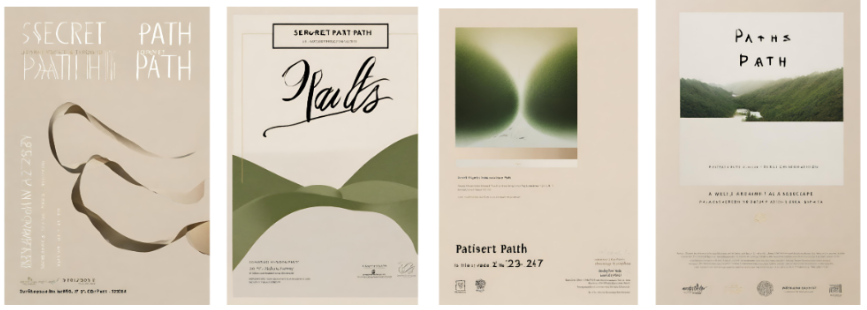
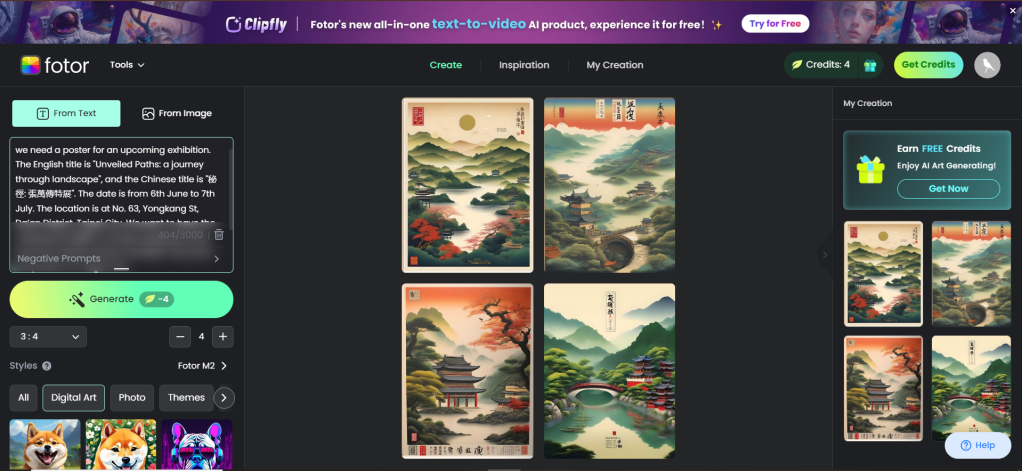

可以留意的是,付費訂閱能擴大這些平台的功能。然而,我們希望優先考慮印刷材料和建立網站的成本,再加上時間的緊迫性,所以決定不購買這些擴增的功能。另外,我們已有許多關於視覺效果的設計想法【圖6】,因此認為進一步諮詢AI在創意設計過程中並非必要,而是更專注於創作我們自己的作品。

我們從 Toby Hu 設計的「敦煌人」海報【圖 7】(Reference poster found on Pinterest: https://reurl.cc/VzLbrR, accessed on 15 April 2024)中獲得了靈感並確定最後設計概念,其實與這個設計類似的風格已經出現在如電影、營建業等的海報上。將標題文字平鋪延伸在地面上的設計,啟發我們也將展覽中文標題形象化為想像的路徑。同時,配合英文標題「Unveiled」有著「揭開」的含意,也讓我們想到填入畫作色彩的點子,像是在預告展品風格【圖8】(展覽暫定海報)。在執行過程中,我們也嘗試使用AI來完成各種任務,例如製作書法風格的標題,或是擷取其風景畫中的點景人物作為設計元素和貼紙圖樣。然而結果並不樂觀。因為我們主要使用的是英文AI平台,無法製作出書法風格的標題。想要去除人物背景的時候,由於張萬傳使用速寫的筆觸描繪人物,因此人物與背景融合在一起,AI無法分辨【圖 9】,還是需要在繪圖軟體上用人為判斷手動勾勒出輪廓。

海報設計參考 (2024.04.15 參考自Pinterest: https://reurl.cc/VzLbrR)。圖版來源:作者提供。

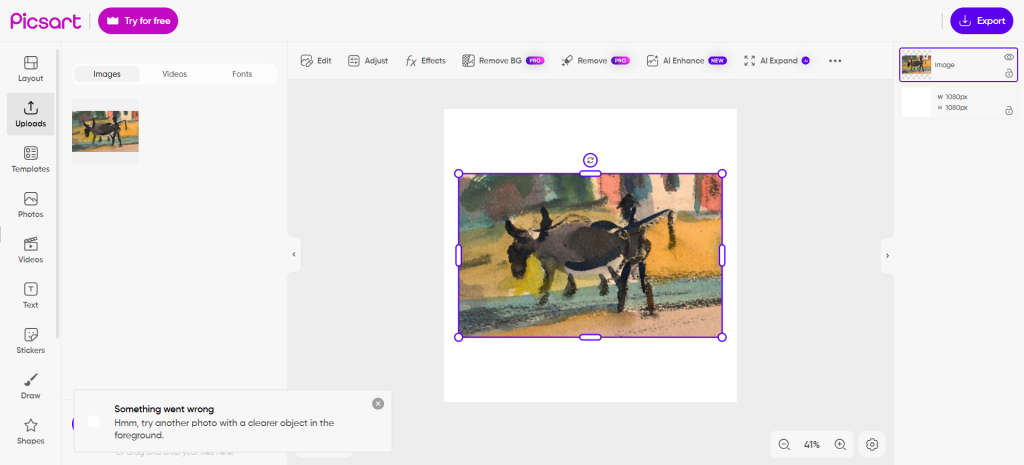
未來用途
在接下來的行銷策略任務中,我們打算在網站創建中使用AI。當我們開始設定網站時,AI會提出一些問題,幫助我們制定網站大綱,以及找到適合我們的模板。但是即便根據我們的要求,它還是會犯一些錯誤,這就需要我們自己進行修改。【圖 10】不過我們可以預見,AI對我們小組的最大貢獻是為我們的雙語展覽進行翻譯,以及在最後一刻進行語法檢查。
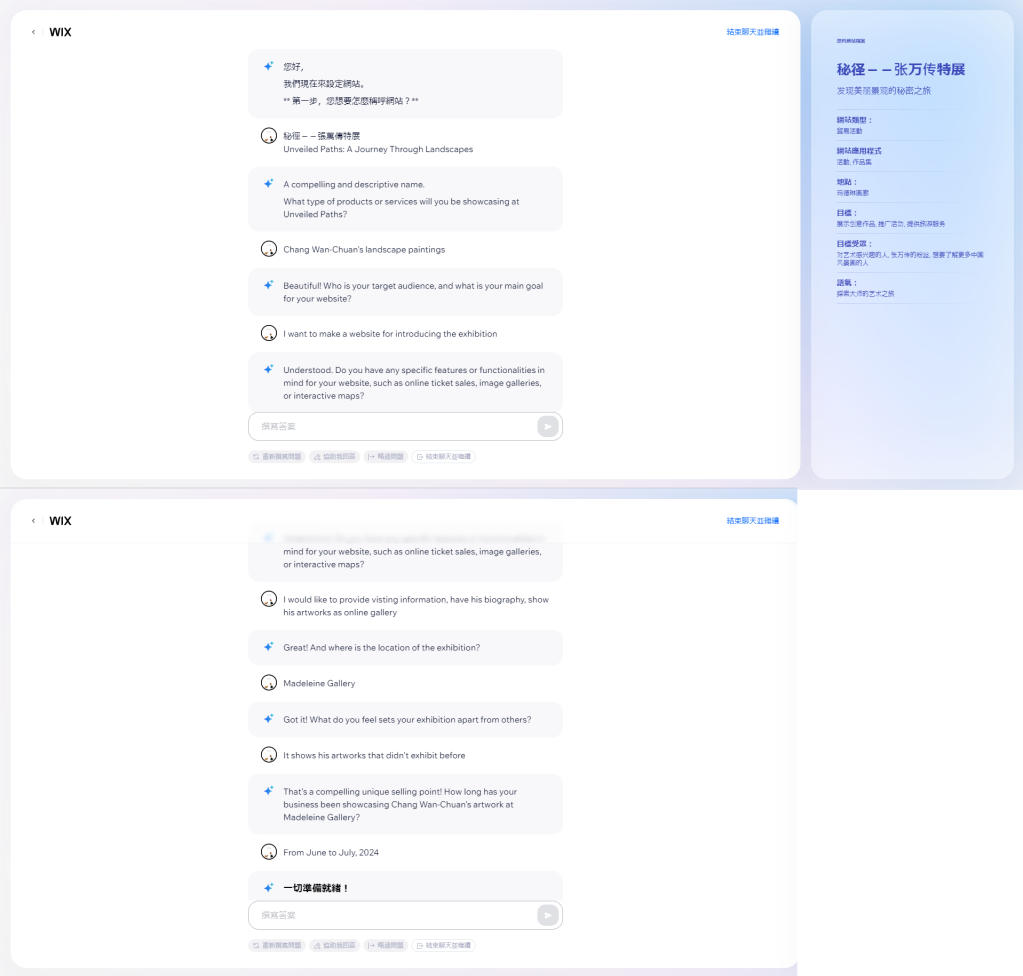
總之,從我們的經驗來看,AI並不是要替我們完成工作,而是要協助我們以更有效的方式進行創作;可以預見運用AI進行視覺設計時,如移除或替換背景、選取填色,還是有機會幫助設計師節省瑣碎工作的時間。然而,如果設計師僅依賴AI提供的結果,創造力將受到極大限制。另外,版權影像上傳到平台的安全性也令人擔憂。當然目前得到的經驗可能是因為我們還不知道如何有效率地使用AI,因為我們對這項技術還很陌生,不過,試用用戶確實很難在有限的存取權限內看到它真正的潛力。至於最後與AI一同策展的成果如何呢?歡迎大家來看看!
「秘徑——張萬傳特展」
日期:2024年6月6日至7月7日(週三至週日、13:00-17:00)
地點:瑪德蓮藝廊(臺北市大安區永康街63號)
What would it be like to curate an exhibition with A.I.? The visual design
Author: Joanne Acompanado, Johanna Dreike, Romy Lan, Elisa Tsai, Evelyn Wu,
Editor: Chia-Chiu Tsai
One of our tasks in curating an exhibit of Chang Wan-Chuan(1909-2003)for our EMI course “Modern Taiwanese and East-asian Art History” at the Graduate Institute of Art History, NTNU included incorporating the growing technology of artificial intelligence (AI) while we worked on the planning and administration of the exhibit and documented the process. The exhibition is not made for business interests, with no intention to invade any intellectual property rights, and only provided for educational and academic purposes. Upon dividing the class into three groups, each was in charge of different aspects of the curatorial process: design and marketing, installation and event planning, and administration and budget planning. Our group is responsible for designing the main visual and planning the exhibition’s marketing, including creating promotional materials like posters, cool cards, and a new website for the exhibition and developing strategies for further promotion.
The rapid developments regarding the usage of AI art currently raise issues of art theft and ownership, but it can also be seen as a new possibility, assisting for example, in creative processes and providing guidance and inspiration. These are just a few examples of how this technology currently affects and shapes the art sector and therefore our work. Despite being skeptical about using this technology, we worked along each step with the AI application and documented the results. After determining the title and general narrative of the overall exhibit with other groups, we proceeded to list what types of material or deliverables to produce and then began the design stage.
Creating the main visual
The first step in our design process was creating the main visual. We began with working on a poster concept. After some trial text prompts when consulting with AI, we found that the free version of the most commonly used AI platform, ChatGPT, does not allow you to upload images (an upgrade to ChatGPT 4 or PRO would be necessary), nor does it produce images when providing a detailed description of elements to feature for the design. Though not providing visual aids, ChatGPT offers you step-by-step guidance on how to design a poster while also advising you to collaborate with a designer (fig. 1).
In the next step, we tested other free image-generating AI platforms, such as Canva’s Magic Media, Fotor, and Visme. Limited to image generation prompted by simple text descriptions, they only produce a small selection of different poster designs using basic templates that do not support further graphic editing. For example, when we provided the exact bilingual title of our exhibition, the design concept we aimed for, and specified the preferred color scheme, the AI-generated posters by Canva’s Magic Media (fig 2-3) featured elements that did not match our intended concept and displayed illegible titles. Only the hue of the posters matched our inserted descriptions. Upon examining the AI-generated images, we found that the compositions were peculiar, featuring scattered arrangements of abstract forms. Fotor, on the other hand, created four different digitally painted Chinese landscapes as the dominant elements (fig.4-5). Moreover, the images were unrelated to the artist we have listed, which would create a misleading poster for our exhibit. Visme provides only a limited selection of templates that the group felt restricted our ideas.
It is worth noting that a paid subscription would expand the accessible features of these platforms. Because we wanted to prioritize essential expenses like the printing of materials and the cost of establishing a website, and because of our short timeframe, we decided against purchasing such a description. Since our group already had various ideas for visuals we wanted to include in the design (fig. 6), we did not feel the need to consult AI in our creative design process further and rather focused on creating our own compositions.
We finalized the concept after several ideas – we took inspiration from a concept poster of “敦煌人” (fig. 7) by Toby Hu. The way the text is laid out on the poster floor inspired us to use the Chinese title as the imaginary path. At the same time, we had the idea of “unveiling” parts of the painting as a teaser for the collection (fig. 8). In the execution process, we also attempted to use AI for various tasks like creating Chinese calligraphy or removing the background of some figures to be used as separate elements and stickers. The results were not promising however, as we primarily used English AI platforms and could not get any results for the calligraphy. While the figures that required outlining were from paintings that utilized rapid brushstrokes, the subjects were embedded within the background and required some human judgment for an outline (fig. 9).
Future Usage
In our upcoming marketing strategy tasks, we intend to employ AI to create our website. When we start to set up the website, AI will ask some questions to help us create an outline for creating the website. It can help us to find which template is suitable for us. However, there were still some mistakes in the results from our text prompt, and we had to revise it manually. (Ref. 10) In addition, we can foresee that the largest contribution of AI to our group would be translating for our bilingual exhibit and any last-minute grammar check.
In conclusion, through our experiences, AI is not meant to do our jobs for us but assist in more effective ways of creation; its functions, such as removing or replacing backgrounds and generative fill, can be anticipated to help designers save time in menial tasks. Creativity would be greatly limited if designers relied only on the results of what AI provided. Furthermore, there are concerns about the security of copyrighted images when uploaded onto the platform. It is also possible we do not know how to efficiently work with AI yet as we are new to the technology, however, it may be difficult for trial users to see its true potential with limited access.



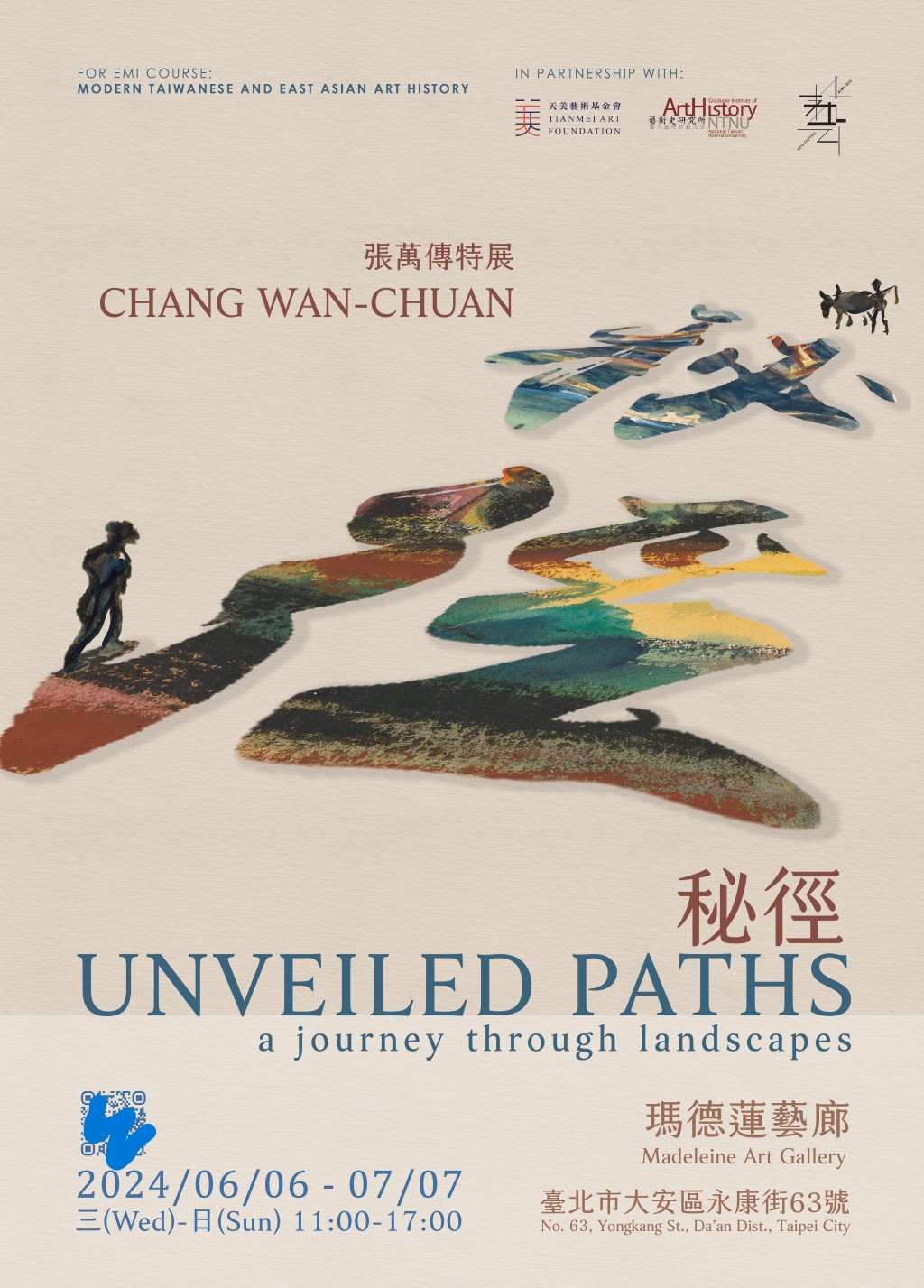



發表留言